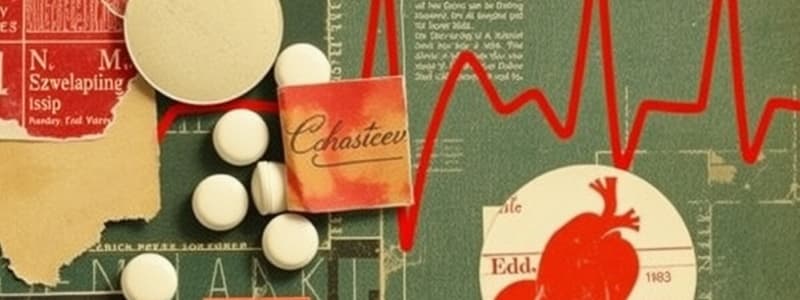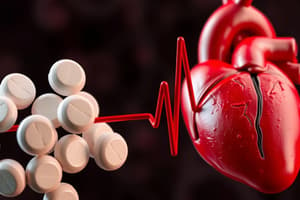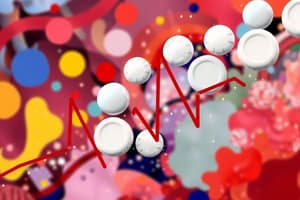Podcast
Questions and Answers
What is the primary effect of Class I-C drugs on the heart?
What is the primary effect of Class I-C drugs on the heart?
- Increase the refractory period (correct)
- Increase heart rate
- Reduce automaticity
- Shorten the refractory period
Which class of drugs blocks the effects of sympathetic stimulation in the heart?
Which class of drugs blocks the effects of sympathetic stimulation in the heart?
- Class II (correct)
- Class III
- Class I
- Class IV
What is a common condition treated with beta-blockers?
What is a common condition treated with beta-blockers?
- QT interval prolongation
- Ventricular fibrillation
- Atrial flutter (correct)
- Atrial tachycardia
What is the main mechanism of action for Class III drugs?
What is the main mechanism of action for Class III drugs?
Which of the following is a potential side effect of Class III drugs?
Which of the following is a potential side effect of Class III drugs?
Which of the following medications is a beta-adrenergic blocker?
Which of the following medications is a beta-adrenergic blocker?
Class III drugs are mainly effective for which type of arrhythmias?
Class III drugs are mainly effective for which type of arrhythmias?
What condition can Class I-C drugs notably exacerbate in patients?
What condition can Class I-C drugs notably exacerbate in patients?
What is the primary purpose of antidysrhythmic drugs?
What is the primary purpose of antidysrhythmic drugs?
Which class of antiarrhythmic drugs is known for moderately blocking sodium channels?
Which class of antiarrhythmic drugs is known for moderately blocking sodium channels?
How do Class I-B antiarrhythmic drugs primarily function?
How do Class I-B antiarrhythmic drugs primarily function?
What is a potential risk associated with Class I-A antiarrhythmic drugs?
What is a potential risk associated with Class I-A antiarrhythmic drugs?
Which class of antiarrhythmic drugs is particularly effective for ventricular arrhythmias after a heart attack?
Which class of antiarrhythmic drugs is particularly effective for ventricular arrhythmias after a heart attack?
What is the primary effect of Class I-C antiarrhythmic drugs?
What is the primary effect of Class I-C antiarrhythmic drugs?
What does the Vaughan-Williams classification system categorize?
What does the Vaughan-Williams classification system categorize?
What effect do Class I-A drugs have on the refractory period of the heart?
What effect do Class I-A drugs have on the refractory period of the heart?
What is the primary use of glycoprotein IIb/IIIa inhibitors?
What is the primary use of glycoprotein IIb/IIIa inhibitors?
Which enzyme is responsible for the breakdown of fibrin in thrombolytic therapy?
Which enzyme is responsible for the breakdown of fibrin in thrombolytic therapy?
What is the mechanism of action of antifibrinolytics?
What is the mechanism of action of antifibrinolytics?
Statins are primarily used to manage what condition?
Statins are primarily used to manage what condition?
What is the effect of thrombolytic agents when used in emergencies?
What is the effect of thrombolytic agents when used in emergencies?
Which of the following is an example of a thrombolytic drug?
Which of the following is an example of a thrombolytic drug?
What is the role of statins in cholesterol management?
What is the role of statins in cholesterol management?
In which condition would antifibrinolytics be primarily used?
In which condition would antifibrinolytics be primarily used?
What effect does blocking L-type calcium channels have in cardiac muscle cells?
What effect does blocking L-type calcium channels have in cardiac muscle cells?
Which class of drugs is specifically mentioned for the management of supraventricular arrhythmias?
Which class of drugs is specifically mentioned for the management of supraventricular arrhythmias?
What is the primary mechanism of action of adenosine in arrhythmia management?
What is the primary mechanism of action of adenosine in arrhythmia management?
For what primary purpose is digoxin used in managing heart conditions?
For what primary purpose is digoxin used in managing heart conditions?
What is the main effect of class IV calcium channel blockers on the SA node?
What is the main effect of class IV calcium channel blockers on the SA node?
Which of the following is NOT a function of coagulation modifier drugs?
Which of the following is NOT a function of coagulation modifier drugs?
What kind of arrhythmias can be effectively managed by class IV drugs?
What kind of arrhythmias can be effectively managed by class IV drugs?
What principle does digoxin primarily utilize to increase cardiac contractility?
What principle does digoxin primarily utilize to increase cardiac contractility?
What is the primary effect of statins on LDL cholesterol levels?
What is the primary effect of statins on LDL cholesterol levels?
Which mechanism do bile acid sequestrants use to lower LDL cholesterol?
Which mechanism do bile acid sequestrants use to lower LDL cholesterol?
Which nutrient level is primarily altered by fibrates?
Which nutrient level is primarily altered by fibrates?
What is one of the pleiotropic effects of statins?
What is one of the pleiotropic effects of statins?
What happens to hepatic cholesterol levels as a result of bile acid sequestrants' action?
What happens to hepatic cholesterol levels as a result of bile acid sequestrants' action?
Which receptor do fibrates activate to promote triglyceride breakdown?
Which receptor do fibrates activate to promote triglyceride breakdown?
What is a common combination strategy for maximizing lipid-lowering effects?
What is a common combination strategy for maximizing lipid-lowering effects?
What effect do statins have on LDL receptors in the liver?
What effect do statins have on LDL receptors in the liver?
What is the primary effect of fibrates on cholesterol levels?
What is the primary effect of fibrates on cholesterol levels?
How does niacin affect triglycerides in the body?
How does niacin affect triglycerides in the body?
What is the mechanism of action of ezetimibe?
What is the mechanism of action of ezetimibe?
What effect does niacin have on HDL cholesterol levels?
What effect does niacin have on HDL cholesterol levels?
What is a common side effect of high doses of niacin?
What is a common side effect of high doses of niacin?
What do PCSK9 inhibitors target in their action?
What do PCSK9 inhibitors target in their action?
What is a typical LDL cholesterol reduction from ezetimibe?
What is a typical LDL cholesterol reduction from ezetimibe?
Which protein does niacin increase to raise HDL levels?
Which protein does niacin increase to raise HDL levels?
Flashcards
Antiarrhythmic Drugs
Antiarrhythmic Drugs
Medications used to treat irregular heartbeats (arrhythmias) by regulating the heart's electrical activity.
Vaughan-Williams Classification
Vaughan-Williams Classification
A system used to categorize antiarrhythmic drugs based on their mechanism of action.
Class I Antiarrhythmics
Class I Antiarrhythmics
Drugs that act by blocking sodium channels, influencing the heart's electrical conduction.
Class I-A Antiarrhythmics
Class I-A Antiarrhythmics
Signup and view all the flashcards
Class I-B Antiarrhythmics
Class I-B Antiarrhythmics
Signup and view all the flashcards
Class I-C Antiarrhythmics
Class I-C Antiarrhythmics
Signup and view all the flashcards
Quinidine, Procainamide, Disopyramide
Quinidine, Procainamide, Disopyramide
Signup and view all the flashcards
Lidocaine, Mexiletine
Lidocaine, Mexiletine
Signup and view all the flashcards
Class I-C Antiarrhythmic Effect
Class I-C Antiarrhythmic Effect
Signup and view all the flashcards
Class I-C Antiarrhythmic Risk
Class I-C Antiarrhythmic Risk
Signup and view all the flashcards
Beta-Blockers: Mechanism
Beta-Blockers: Mechanism
Signup and view all the flashcards
Beta-Blocker Action
Beta-Blocker Action
Signup and view all the flashcards
Class III Antiarrhythmic Key Function
Class III Antiarrhythmic Key Function
Signup and view all the flashcards
Class III Antiarrhythmic Mechanism
Class III Antiarrhythmic Mechanism
Signup and view all the flashcards
Class III Antiarrhythmic Use
Class III Antiarrhythmic Use
Signup and view all the flashcards
Class III Antiarrhythmic Side Effect
Class III Antiarrhythmic Side Effect
Signup and view all the flashcards
Verapamil and Diltiazem
Verapamil and Diltiazem
Signup and view all the flashcards
How Class IV Antiarrhythmics work
How Class IV Antiarrhythmics work
Signup and view all the flashcards
Why are Class IV drugs useful for Arrhythmias?
Why are Class IV drugs useful for Arrhythmias?
Signup and view all the flashcards
Adenosine Mechanism of Action
Adenosine Mechanism of Action
Signup and view all the flashcards
Adenosine Effect
Adenosine Effect
Signup and view all the flashcards
Digoxin Mechanism of Action
Digoxin Mechanism of Action
Signup and view all the flashcards
Digoxin Uses
Digoxin Uses
Signup and view all the flashcards
What are Glycoprotein IIb/IIIa inhibitors used for?
What are Glycoprotein IIb/IIIa inhibitors used for?
Signup and view all the flashcards
Fibrates: Mechanism
Fibrates: Mechanism
Signup and view all the flashcards
How do thrombolytic (fibrinolytic) drugs work?
How do thrombolytic (fibrinolytic) drugs work?
Signup and view all the flashcards
Fibrates: Effect
Fibrates: Effect
Signup and view all the flashcards
What are some common examples of thrombolytic drugs?
What are some common examples of thrombolytic drugs?
Signup and view all the flashcards
What is the action of antifibrinolytics?
What is the action of antifibrinolytics?
Signup and view all the flashcards
Niacin (Vitamin B3): Mechanism
Niacin (Vitamin B3): Mechanism
Signup and view all the flashcards
Niacin: Effect
Niacin: Effect
Signup and view all the flashcards
What are some examples of antifibrinolytic drugs?
What are some examples of antifibrinolytic drugs?
Signup and view all the flashcards
Cholesterol Absorption Inhibitors: Mechanism
Cholesterol Absorption Inhibitors: Mechanism
Signup and view all the flashcards
What is the aim of antilipemic drugs?
What is the aim of antilipemic drugs?
Signup and view all the flashcards
How do statins work to lower cholesterol?
How do statins work to lower cholesterol?
Signup and view all the flashcards
Cholesterol Absorption Inhibitors: Effect
Cholesterol Absorption Inhibitors: Effect
Signup and view all the flashcards
Why are statins such a common treatment for high cholesterol?
Why are statins such a common treatment for high cholesterol?
Signup and view all the flashcards
PCSK9 Inhibitors: Mechanism
PCSK9 Inhibitors: Mechanism
Signup and view all the flashcards
PCSK9 Inhibitors: Examples
PCSK9 Inhibitors: Examples
Signup and view all the flashcards
Statins: Action
Statins: Action
Signup and view all the flashcards
Statins: Effect on Lipids
Statins: Effect on Lipids
Signup and view all the flashcards
Bile Acid Sequestrants: Mechanism
Bile Acid Sequestrants: Mechanism
Signup and view all the flashcards
Bile Acid Sequestrants: Effect
Bile Acid Sequestrants: Effect
Signup and view all the flashcards
Pleiotropic Effects
Pleiotropic Effects
Signup and view all the flashcards
Lipid-Lowering: Combination Therapy
Lipid-Lowering: Combination Therapy
Signup and view all the flashcards
Study Notes
Antidysrhythmic Drugs
- Antiarrhythmic drugs treat irregular heartbeats (arrhythmias), such as atrial fibrillation, ventricular tachycardia, and atrial flutter.
- They work by modifying the heart's electrical activity to restore normal rhythm.
- The Vaughan-Williams classification system groups antiarrhythmic drugs into four classes based on their mechanism of action.
Class I: Sodium Channel Blockers
- These drugs block sodium channels during the action potential, slowing depolarization and sometimes conduction.
- Class I-A (e.g., Quinidine, Procainamide, Disopyramide): Moderately block sodium channels during depolarization, prolonging action potential and increasing the refractory period. They also block potassium channels, prolonging repolarization and increasing the QT interval; risk of torsades de pointes.
- Class I-B (e.g., Lidocaine, Mexiletine): Primarily bind to sodium channels during the depolarized state, shortening action potential duration and decreasing the refractory period; preferentially affect ischemic or depolarized tissue, used for ventricular arrhythmias, particularly after a heart attack.
- Class I-C (e.g., Flecainide, Propafenone): Strongly block sodium channels during depolarization, significantly slowing conduction velocity; have little effect on action potential duration but increase the refractory period; used for both atrial and ventricular arrhythmias, especially supraventricular arrhythmias.
Class II: Beta-Adrenergic Blockers
- These drugs block the effects of sympathetic stimulation on the heart, particularly at beta-1 adrenergic receptors.
- Examples include Propranolol, Metoprolol, Atenolol, Esmolol.
- Mechanism of Action: Block beta-1 adrenergic receptors to reduce heart rate and contractility, decrease automaticity, and slow conduction through the atrioventricular (AV) node.
- They increase the refractory period of the AV node and are used to treat atrial fibrillation, atrial flutter, and ventricular arrhythmias to control rate in supraventricular arrhythmias and post-myocardial infarction.
Class III: Potassium Channel Blockers
- These drugs block potassium channels, prolonging repolarization and increasing the refractory period.
- Examples include Amiodarone, Sotalol, Dofetilide, Ibutilide.
- Mechanism of Action: Block potassium channels (specifically delayed rectifier potassium channels). This prolongs the action potential duration and the refractory period. This effect prevents reentry circuits, thereby stabilizing the heart's rhythm.
- Effect: Effective for both supraventricular and ventricular arrhythmias, including atrial fibrillation, ventricular tachycardia, and ventricular fibrillation. Potentially increases QT interval, increasing risk of torsades de pointes.
Class IV: Calcium Channel Blockers
- These drugs block L-type calcium channels in the SA node, AV node, and myocardium, slowing the rate of depolarization and conduction velocity.
- Examples include Verapamil, Diltiazem.
- Mechanism of Action: Block L-type calcium channels, decreasing intracellular calcium. This slows the rate of depolarization and conduction velocity.
- Effect: Effective in supraventricular arrhythmias such as atrial fibrillation and atrial flutter, controlling rate to prevent rapid atrial impulses from reaching the ventricles. Also used to manage paroxysmal supraventricular tachycardia.
Other Antiarrhythmic Drugs
- These drugs don't fit neatly into the Vaughan-Williams classification, but remain important in management.
- Adenosine: Activates A1 adenosine receptors in the heart, hyperpolarizing and decreasing conduction through the AV node. This block can reset the heart's rhythm and is primarily used for acute termination of SVT (supraventricular tachycardia), especially reentrant arrhythmias involving the AV node.
- Digoxin: Inhibits the Na+/K+ ATPase pump, increasing intracellular calcium; increases contractility and slows conduction through AV node. Used for rate control in atrial fibrillation and atrial flutter. Used in heart failure.
Coagulation Modifier Drugs
- Coagulation modifier drugs manage conditions related to blood clotting, for example, deep vein thrombosis (DVT), pulmonary embolism (PE).
- Anticoagulants: Prevent clot formation; examples include Heparins (unfractionated and low molecular weight) and Vitamin K antagonists (e.g., warfarin). Unfractionated Heparin binds to antithrombin III, enhancing its activity. Low Molecular Weight Heparins primarily inhibit factor Xa. Warfarin inhibits vitamin K-dependent clotting factors (II, VII, IX, X); prevents activation of these clotting factors, thereby reducing clot formation.
- Administration and Monitoring: Administration varies depending on type of anticoagulant; monitoring (e.g., INR) is important for some drugs to adjust dosage and maintain therapeutic levels.
- Direct Oral Anticoagulants (DOACs): Directly inhibit factor Xa, or thrombin; examples include Apixaban, Rivaroxaban, Edoxaban, Dabigatran.
Antiplatelet Drugs
- Antiplatelet drugs inhibit platelet aggregation, preventing clot formation.
- Aspirin (Acetylsalicylic Acid): Irreversibly inhibits cyclooxygenase-1 (COX-1); reduces thromboxane A2 (TXA2) production, reducing platelet aggregation.
- P2Y12 Inhibitors (e.g., Clopidogrel, Prasugrel, Ticagrelor): Block P2Y12 receptors on platelets, which are involved in platelet aggregation.
- Glycoprotein IIb/Illa Inhibitors (e.g., Abciximab, Eptifibatide, Tirofiban): Block GPIIb/IIIa receptors, preventing platelet aggregation and fibrinogen binding.
Thrombolytic (Fibrinolytic) Drugs
- Thrombolytic drugs break down existing clots by activating plasminogen, which converts to plasmin. The enzyme, plasmin, degrades fibrin. Examples: tPA (Tissue Plasminogen Activator), Alteplase, Reteplase, Tenecteplase.
- Effect: Used in emergency situations for acute myocardial infarction (MI), acute ischemic stroke, and pulmonary embolism (PE).
Antilipemic Drugs (Lipid-Lowering Drugs)
- Statins (HMG-CoA Reductase Inhibitors): Inhibit HMG-CoA reductase, reducing cholesterol synthesis in the liver. Examples include Atorvastatin, Simvastatin, Rosuvastatin, and Pravastatin.
- Bile Acid Sequestrants (Resins): Bind to bile acids in the intestines, preventing their reabsorption and increasing cholesterol excretion. Examples include Cholestyramine, Colestipol, and Colesevelam.
- Fibrates (Fibric Acid Derivatives): Activate peroxisome proliferator-activated receptor alpha (PPAR-α); affects lipid metabolism. Increase lipoprotein lipase activity, and decrease apolipoprotein C-III synthesis to increase triglyceride breakdown; Examples include Gemfibrozil and Fenofibrate.
- Nicotinic Acid (Niacin): Inhibits lipolysis; lowers triglycerides and increases HDL cholesterol.
- Cholesterol Absorption Inhibitors: Inhibit certain intestinal proteins (e.g., NPC1L1) that absorb dietary cholesterol, reducing cholesterol absorption. Examples include Ezetimibe.
- PCSK9 Inhibitors: Newer biologic agents that bind to PCSK9, preventing its interaction with LDL receptors. Examples include Alirocumab, and Evolocumab.
- Omega-3 Fatty Acids: Decrease hepatic synthesis of triglycerides, increasing lipoprotein lipase activity. Examples include Fish oil (EPA and DHA), Icosapent ethyl.
Studying That Suits You
Use AI to generate personalized quizzes and flashcards to suit your learning preferences.
Related Documents
Description
This quiz explores the primary effects of Class I-C antiarrhythmic drugs on the heart. Test your understanding of how these medications influence cardiac function and their mechanisms of action in treating arrhythmias.




